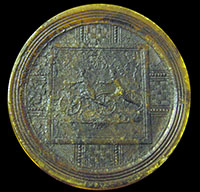

1819 Hobby Horse Replica
(Now sold)

This excellent replica Hobby Horse was built by Philip Jenkinson in 1993 and for the past twenty years was on display in his museum in Shebbear, Devon. It was used for local displays and parades. I purchased it from his son Kevin.
It is very usable, once you get used to the principle of ‘swift-walking’ as it was known at the time. The front wheel turns, and the machine can reach speeds of up to 8mph. The only thing to remember is to be very careful going downhill as brakes had not yet been invented in 1819!
The interesting thing about building a machine of this type is that despite it being nearly two centuries since the Hobby Horse was invented, traditional carpentry, blacksmith, saddlemaking and wheelwright skills have not changed that much. So it’s possible to use similar methods of construction to create a very authentic replica of the 1819 machines. Compare this machine with the 1857 sketch below, of an English 1919 Johnson Hobby Horse.

There are a few original surviving Hobby Horses, though they’re in museums. Even if you were lucky enough to own one, you’d hardly want to risk using it if you’d paid a six figure sum for it. So enthusiasts build their own, and many also ride them in vintage events. Below you can see Ivan Krivanak from the Czech Republic; I photographed him in 2011 when we both attended the IVCA vintage cycle run in France.




PINNOCK’S CATECHISM OF MECHANICS
The following explanation of the Hobby Horse appeared in ‘Pinnock’s Catechism of Mechanics,’ published in 1823.








JOHNSON’S HOBBY HORSE
Denis Johnson (b. c.1760) was a coachmaker who patented the ‘Pedestrian Curricle’, or ‘Hobby Horse’, in England (1818/4,321). His premises were located at 75 Long Acre, London.
It seems that just over 300 machines were produced with production having been estimated at around 25 a week. Two were sold in May 1819 to the Duke of Northumberland for £11 each. The early machines had steering by long, curved, iron rods that connected to the front wheel hub. Most though were produced with the handlebar operating directly onto the top of the front forks.
Johnson managed to improve the hobby horse as compared to von Drais with iron forks instead of wood, a curved frame that was more elegant and lighter at around 50 lbs.

































